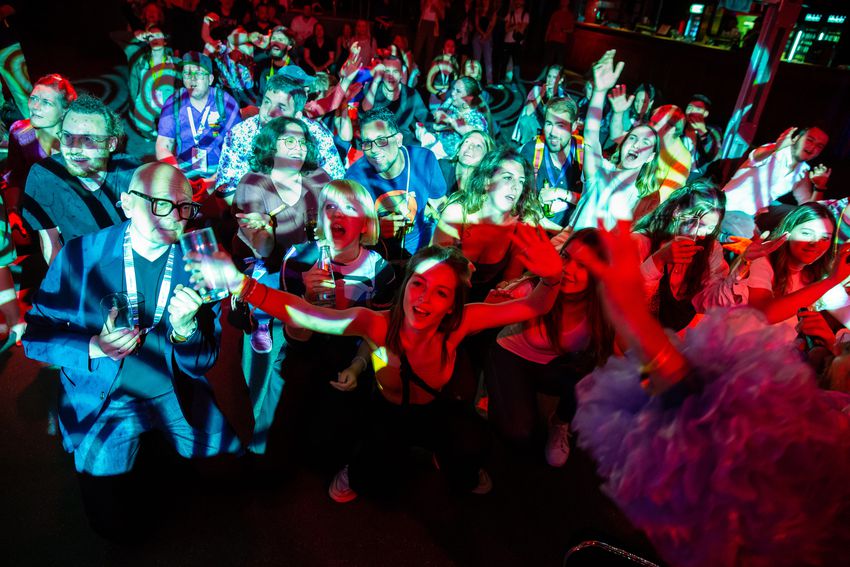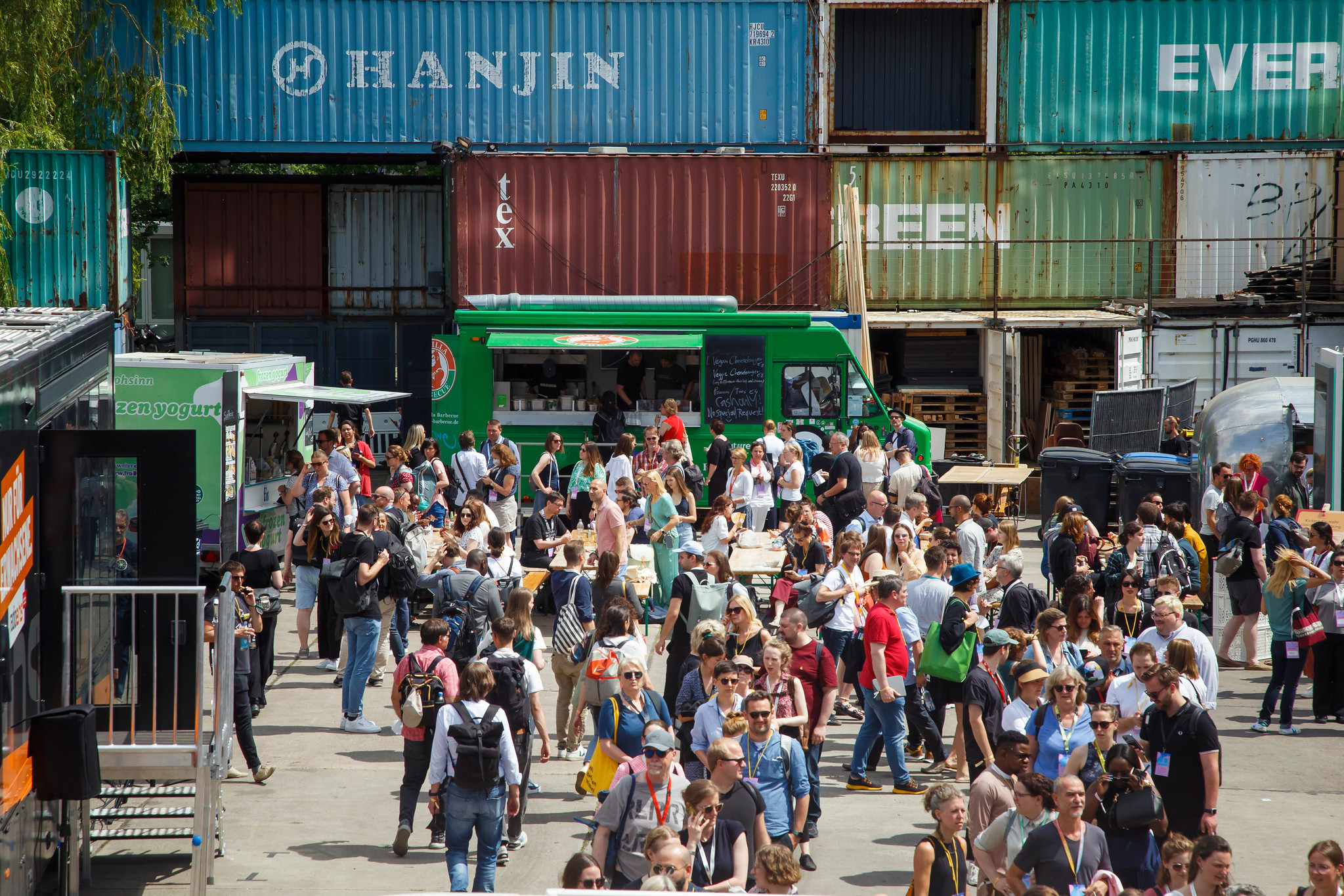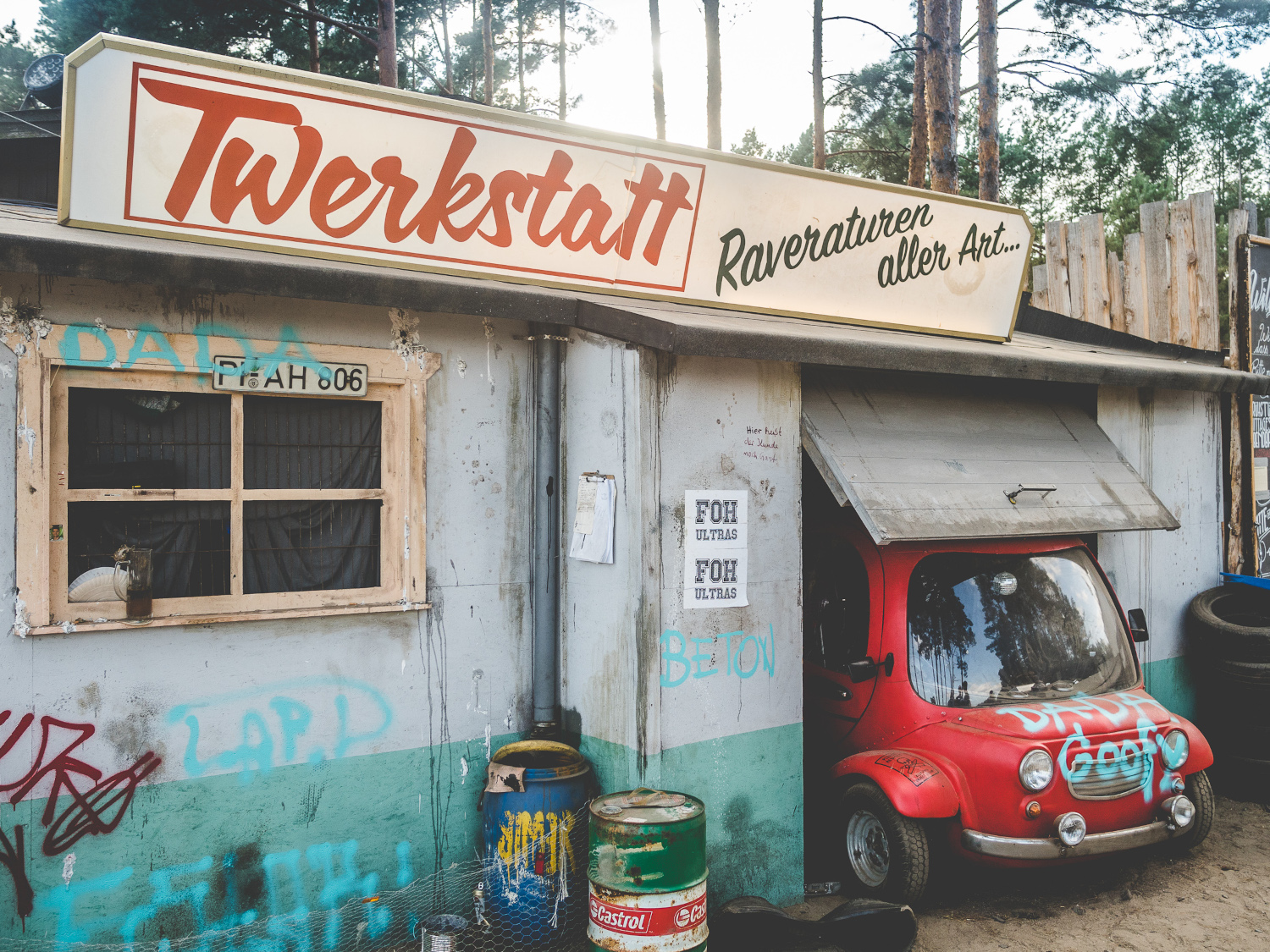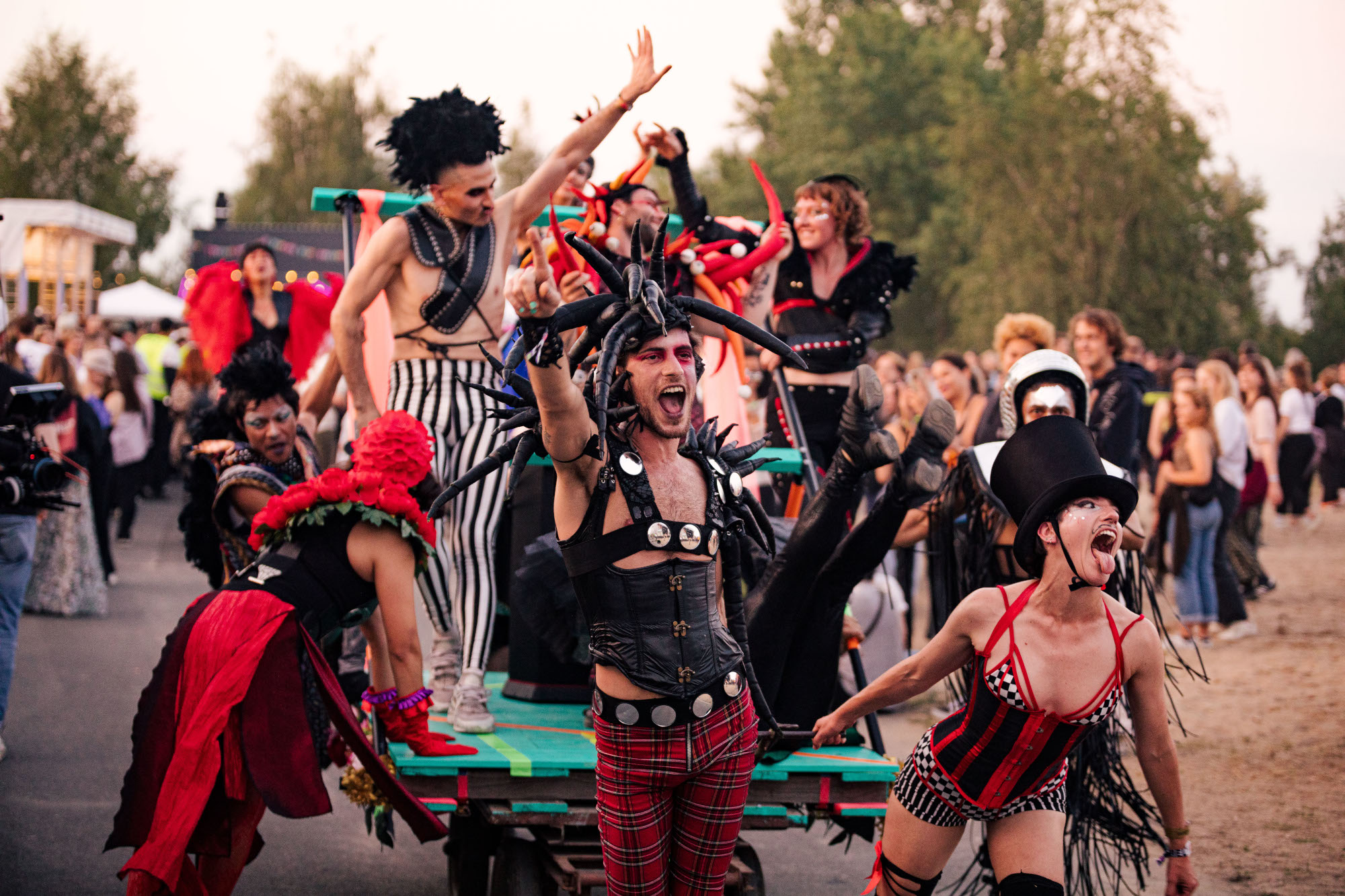Sustainability
Ella Einhell: "Happy beef is always blue"
Ella Einhell turns bones into glass, drawing on an old …

The festival landscape is facing a radical change: more and more festivals want to become sustainable. But how do you switch to sustainability? We introduce you to five festival organizers that took action - and ask what hurdles they had to overcome.
Not all festivals are the same. They differ in size and infrastructure, in their socio-cultural and commercial orientation. These factors are closely linked and have a significant influence on the design of an event. The Shambala Festival in England, for example, has opted for an eco-friendly and inclusive orientation from the very beginning. Since the festival's inception in 2010, its Co2 footprint has been reduced by 90 percent, and attendance has intentionally remained constant at 15,000 people. Burning Man, on the other hand, which has embraced the well-known 'leave-no-trace philosophy' since the mid-1980s, has grown steadily and has remained constant at 80,000 visitors for years - with far-reaching consequences for the environment.
But what can festival organizers do to reduce their Co2 emissions? Which obstacles do they have to overcome? And: Does a sustainable design cost more in the end? We talked about this with the persons in charge for sustainability from Wurzelfestival, Burning Man, Goodlive GmbH (Melt, Splash!, Full Force and others), Bucht der Träumer and Re:publica.
Mobility, Transport and Logistics
By far the largest cause of the greenhouse gas emissions of any event is the arrival and departure of guests. Not surprisingly, this item varies depending on the size and infrastructure of the event. According to Atmosfair, a non-profit climate protection organization, travel to and from events in Germany accounts for an average of 70 percent of an event's total emissions. At Burning Man in Nevada, this item accounted for as much as 91 percent of the festival's total emissions consumption in 2019, according to a climate assessment. In total, more than 54,000 metric tons of Co2 were emitted, which is equivalent to about 12,000 cars driving throughout the year. Almost a third of the guests flew in from all over the world - about 130 million air miles. Here, the limits of the potential to reduce emissions become very clear. Burning Man organizers are highly unlikely to develop green fuel for aircraft. They won't incentivize all guests coming by car to buy a Tesla, and they won't lay tracks from San Francisco to Nevada (trains are a rarity in the U.S. anyway). Now festival organizers could simply say, arrival and departure, that's not my problem, I just take care of what happens on site. But you don't necessarily make friends with this kind of stance, at least you have to be accused of ignorance. So, what can you do?
For organizers who are just starting to get a festival going, the choice of location is crucial. If you are organizing a festival in the desert, you have to expect that it will be difficult to reach. An infrastructure that can rely on the rail network or public transportation has a clear advantage. In addition, there is the good (or not so good) accessibility of the festival site from the nearest train or bus station. If you can create favorable conditions here, you are more than halfway there. Most festivals in the Berlin area, for example, are very easy to reach by regional transport. With the Deutsche Bahn event ticket, participants of trade fairs, congresses or festivals can save money on their travel to and from the event, especially since the ticket is also valid for public transportation. The event must be registered with Deutsche Bahn in order for an event ticket to be offered. This creates an incentive to come by train instead of by car.
Inga Jacobsen (Wurzelfestival): „We are considering to make the festival ticket more expensive for car drivers. That's fair - and it's a good incentive to come by train or bus"
Another - very simple, but effective - thing is to equalize traffic to the festival site by moving the start of the festival to the evening. This gives guests a window of an entire day to arrive. A shuttle service from the nearest train or bus station to the festival is another plus. This is where most festivals hit a snag. Trains are often jammed, shuttle buses are nonexistent or too few, and service providers like Bassliner have limited capacity. The Wurzelfestival, which is located just under an hour south of Berlin, is trying to solve the problem together with Deutsche Bahn by making more trains available for the period when the festival begins. So far, however, the talks have been fruitless. A solution here would be a positive precedent, because the problem affects many festivals in the region, for example also the Bucht der Träumer. A solution here would be an incentive to give up the car. Inga Jacobsen from the Wurzelfestival even goes one step further. She is considering "to make the festival ticket more expensive for people who come by car. Is that fair, we asked ourselves. We think so." Re:publica, held this year at the Arena in Berlin, had car and bike sharing stations and charging stations for e-cars available on the premises. They also had a partnership with Deutsche Bahn for a ticket discount, as well as other mobility partners like Jelbi and WeShare. Hotels for crew and speakers were all within walking distance of the event location. It is clear that something like this only works in a well-connected city.



On essential factors of the arrival and departure of the guests like the traffic connection or the choice of mobility one has only a limited leeway as a festival organizer. Nevertheless, it’s possible to find compensations in a roundabout way. The organizers of the Shambala Festival, for example, invest in wind energy projects in India and in other Co2 compensation projects. Burning Man is also working on such compensation strategies. These can be very different projects: financially supporting tree planting campaigns, investing in renewable energy or, as in the case of the Burning Man, investing in or collaborating with companies that develop Co2 storage technologies. The range of possibilities to compensate Co2 is large - but of course also a question of the wallet.
In terms of in-house mobility, i.e. logistics and transport, however, a lot can be done. The Melt, Splash! and Full Force festivals always take place at the same location: in Ferropolis. The shared infrastructure saves resources and transport routes, as many storage areas are on site and many things, for example stage parts, are reused. The Bucht der Träumer cooperates with another festival that also takes place at Lake Helene and shares transportation costs. And the Burning Man has moved storage space to Gerlach, the closest town to the festival site. The makers of artworks, a basic element of Burning Man, can thus build their artworks directly on site and no longer have to have them transported by ship or train from New York, Berlin and other cities around the globe. And those who don't have the means to cooperate or for storage facilities on site can do as Re:publica did and work specifically with logistics service providers from the immediate vicinity - this can sometimes be more expensive, but saves transport routes.


Energy, Equipment and Design
One hundred percent green electricity, own solar power systems on the grounds and virtually no diesel generators - few festivals have achieved such an optimum. Shambala gets one hundred percent green electricity, Re:publica (this year) almost as well, and Ferropolis even has its own photovoltaic systems on the grounds, which feed as much electricity into the grid per year as Melt needs per festival. But since most festival grounds are leased, the power supply also depends on the leaseholder. If they don't use green electricity, you can't just pull it out of a hat. Here, the choice of location is again crucial (or a conversation with the leaseholder). Installing solar or wind power also depends on owning or leasing the site. At Burning Man, which is organized into camps, it is individual camps that run their area of responsibility on solar power. But the Burners are already planning their own solar farm, which will then provide in-house green power across the board.
Angela Volz (Bucht der Träumer): „We conducted experiments with solar generators. We weren't brave enough to do a whole dance floor with it. But that can still be done“
Green power or investment in renewable energy is just one thing to reduce emissions. Many stages simply cannot be connected to the main power circuit and have to run on diesel generators. Alternatives here could be hydrogen generators, which are still being tested. Or battery storage systems. In terms of equipment, LED seems to be almost a given as the standard for lighting systems. And design can also contribute to the solution. The Wurzelfestival, for example, uses solar light giraffes as lighting in the camping area, and has smaller solar panels scattered everywhere that can be used to electrify this and that, including LED systems. Such local solar-based design solutions can be used in a variety of ways. The prerequisite, however, is that the sun shines during the event. Angela Volz of the Bucht der Träumer says that they have already conducted experiments with solar generators, but admits "that you can do a whole dance floor with it right away, we haven't been that brave yet. But we'll try to implement that in the future where we can."



Design can also be a key element of energy saving in other ways. Keywords: recycling, upcycling, material selection. According to the German Federal Environment Agency, waste from production and trade accounts for more than 47 million tons in Germany each year (2020 calculation). So, a fundamental question is: Do I need this or don't I? Re:publica, for example, has decided to do without lanyards, jute bags and other merchandising. If you don't want to do without, you can pay attention to whether products are sustainably produced or biodegradable. As already mentioned, many things such as stage parts can be reused or used for other purposes through upcycling (screws, molleton, wood, etc.). Parts of the stage then become furniture; multifunctional wooden modules become whatever. Or differently: like the technical equipment, furniture, plants, decoration etc. are simply rented. Either way, the choice of materials makes all the difference. For example, Re:publica chose recyclable polyester for their stage decorations. To avoid plastic, they originally wanted to use a certain nettle fabric (untreated cotton), but then had decided against it because of its unclear origin, especially since the production of cotton is very water-intensive. As a compromise, they then decided to use recyclable polyester. A lot of research is needed to find suitable materials. And it takes a lot of innovation to make upcycling possible. Unfortunately, the devil is in the details.
Waste Management and Catering
Trash is everywhere where people are. According to Jacob Bilabel of the Aktionsnetzwerk Nachhaltigkeit, the amount of trash per capita at a festival is not much higher than in everyday life. But even if it is, what about waste separation? Festivals like Burning Man or the Bucht der Träumer have recycling facilities and separation stations. At the Ferropolis festivals, in addition to a bag for residual waste, a yellow bag was also distributed to guests, which was well received overall. At Fusion and the Bucht der Träumer, a garbage deposit of ten euros is required to encourage guests to be clean and tidy (although one may speculate whether this is not the wrong incentive - namely to produce more garbage to get the bag full). And then there are the tents. Rock am Ring, in cooperation with Utopia, rented tents and camping equipment. There were tent drop-off stations where the dropped-off tents were sewn into bags and jackets. Such solutions can help reduce the number of tents left lying around. Jacob Bilabel even suggests putting festival emblems on tents to give them sentimental value - similar to festival wristbands.
But trash is also a question of the socio-cultural dimension of a festival. Due to the 'leave-no-trace philosophy' of Burning Man, it is not possible to determine exactly how much trash is produced per camp, but one thing is certain: everyone has to take their trash home again. The 'leave-no-trace philosophy' is an incentive to produce less trash. The fundamental question is: which guests do I attract? Who do I want my audience to be? Can I require my guests to be more environmentally conscious, or can they - in a sense - do whatever they want? Producing less waste and the willingness to separate waste is primarily a question of the guests' attitude. The socio-cultural and/or commercial orientation of a festival has a reciprocal effect on waste management.
Sarah Lüngen (CSR Manager Goodlive & Founder The Changency): „We gradually want to make the gastronomic offer in Ferropolis and generally at our festivals more plant-based. This is a very sensitive topic - many people feel that purely vegan food is paternalism“


The amount of waste is also related to catering. Reusable cups, reusable cutlery, etc. with a deposit system are of course ideal, but not always feasible in practice. Because what is used several times also has to be cleaned several times, which is not always logistically possible. Nevertheless, this remains the preferred desired solution of the festival operators we have spoken to. Alternatively, compostable cutlery and plates can be used. For those who don't have a complete solution to the catering waste problem, partial solutions are available. The Wurzelfestival, for example, offers to rent reusable cups; the Bucht der Träumer uses the Cup Concept reusable system. And last but not least, there is the food supply itself. It is undisputed that a meat-free offering significantly reduces emissions. It is also undisputed that a vegan food offer is even lower in emissions than a vegetarian one. But: it is also more expensive. And: a purely vegan meal offer is felt by many as paternalism. Sarah Lüngen from The Changency, for example, says that they "want to gradually make the catering in Ferropolis more plant-based. But that's a very sensitive issue, kind of like the speed limit." Once again, the question arises here as to which audience one can attract and what one can or wants to expect of one's guests.


Transparency and Communication
Communication and transparency are important - both externally and internally. The topic of food is a good example here. The decision to offer only vegan food, as Re:publica aims to do, for example, is essentially a question of open and transparent communication. There is no way to avoid scaring people away with such a decision. On the other hand, whatever changes if you always try to please everyone? The Wurzelfestival is considering making tickets more expensive for people who come by car, a kind of Co2 tax, if you will. Is that fair? How would something like that be received? Being in touch with the community can be helpful here. The Burners, for example, publish after each festival which camps have left their site clean. Camps that weren't quite so neatly cleaned are exposed online to put moral pressure on them; anyone can look to see which camp doesn't care quite as much about the environment. Camps that were particularly careless can even be banned from future participation in the festival. The Burning Man is of course a bit special with its organization in camps. But in general, you can't do it completely without pressure or expectations. People are, well, sluggish. But if you show them alternatives and communicate them transparently, they will probably accept them over time. There are countless examples of this. To mention just one: Smoking bans in bars and public places are now accepted without objection by large sections of society. But if you look back at the political (and social) decision-making process, you will see what a big hullabaloo there was about it back then. Much ado about nothing in the end.
A very important point is above all internal communication: where are the biggest problems and what can be done about them? Most of the festivals we spoke to or researched have not yet prepared a climate assessment of their CO2 emissions. However, this is the basic prerequisite for finding out how things stand in terms of sustainability at the respective festival. This is the only way to identify the most urgent problems and to find and implement measures against them. The climate assessment shows the status quo. Organizers who are just starting to bring an event to life can use this tool from the very beginning and recognize early on where things are going wrong.
Costs of Sustainability
Nantjen Kuesel (Sustainability management at the re:publica): „At the moment, sustainable production causes additional costs, but this does not have to remain a permanent condition. We even assume that sustainable event management can save not only resources but also costs in the long term“
At first glance, the question of costs is easy to answer: yes, making a festival sustainable cost more. It takes staff to research and implement suitable measures; products and services can turn out more expensive; investments have to be made, etc. pepe. However, Nantjen Kuesel of Re:publica counters that "sustainable event management can save not only resources but also costs in the long run." But some things depend on more advanced technology, such as hydrogen generators or battery storage systems. Finally, there is supply and demand. A basic principle of capitalism is: if demand increases, production costs and prices decrease. The demand for eco-toilets, for example, is currently still greater than the supply; if the supply grows, the prices will presumably also shrink. In principle, this applies to all products and services. So, in the long term, sustainable design can pay off. At the moment, there are still too few practical empirical values to make clear statements here. The fact is that there is a margin and at least parts of the costs can be amortized.
Low Barriers and Inclusion
It was important to all festival organizers to also emphasize social sustainability. In other words, to become as barrier-free and inclusive as possible. This means that many festivals now offer tiered ticket prices to allow people on a budget to attend. Many festivals have awareness teams, eclipse facilities, safe spaces, or gender-neutral restrooms. There are teams dedicated solely to how to break down barriers, such as allowing people with visual impairments or other disabilities to participate. In Ferropolis there is even an area where NGOs are allowed to present themselves in order to bring the topic of inclusion etc. more into the awareness of the guests. The topics of inclusion and low barriers are considered by all organizers as a holistic concept of a more sustainable festival design.
Useful information
The German Federal Environment Agency and the German Federal Ministry for the Environment have jointly produced a guide for the sustainable organization of events. Further interesting and useful information on sustainable festivals can also be found at Utopia. We ourselves have already done an interview on this topic with FUCHS & HIRSCH, who advise festivals on sustainability. In addition, the Future of Festivals industry meeting will take place for the second time in Berlin on November 25/26.
Do you know it? Our new magazine on sustainability and culture
You want to have the new CCB Magazine for free? [Click here]
Category: Innovation & Vision
Also a good read
Subscribe to our monthly newsletter!